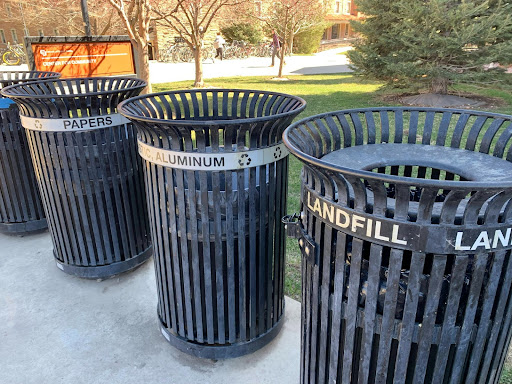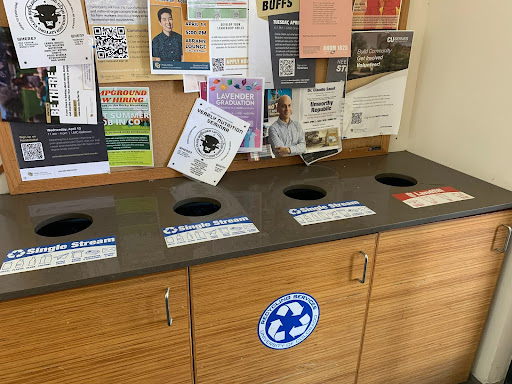What’s the biggest barrier for a university going zero-waste? Education.
In one of the nation’s top schools for sustainability, CU Boulder still faces obstacles in becoming completely zero-waste. One of the biggest obstacles are the students; mainly the lack of knowledge surrounding zero-waste practices such as composting.
Imagine a student sitting at the Center for Community Dining Center, finishing up their food. As they get up to throw away their leftovers, they are faced with three bins: compost, recycling and landfill. Without reading the signs instructing what waste goes in what bin, the student throws the whole tray in the landfill.

The University of Colorado Boulder’s biggest hurdle in the quest for zero waste does not lie in the materials or waste management practices being used, but in the difficulties of properly educating the student population.
To reach a 90% diversion rate of municipal solid waste by 2025, a goal of the school’s Zero Waste Program, student outreach is of the utmost importance, both to the Environmental Center and the Grounds and Recycling Operations Center.
Rated gold by the Sustainability Tracking, Assessment and Rating System (STARS), CU Boulder boasts multiple achievements in sustainability, including the nation’s first student-led environmental center and recycle program. The most impressive may be the school’s waste diversion rate.
Waste diversion refers to the process of pulling products and materials from the trash that can be reused as opposed to put in the landfill.
“We are doing a lot better than most universities and most cities,” said Carl Pierce, CU Boulder’s solid waste and recycling operations manager.
The diversion rate for the 2020-2021 year was recorded at 45.59%, but Pierce said that currently, the rate is a little over 51%. This number is significantly higher than the state of Colorado’s 10.8% diversion rate, which is well below the national average of 34%.
With about 8,000 new students on campus every year, education about recycling right off the bat becomes essential.
“The most waste is coming out of residence halls,” Pierce said. “One of the things we are working on is trying to educate 8,000 students a year that come from all walks of life and different parts of the country.”
On campus, the Environmental Center provides opportunities for students to learn, discuss and get involved in the environment.
Robin Poley, the zero waste program assistant for events and operations at the Environmental Center, explained that a part of his job is setting up recycling bins for cardboard, styrofoam and film plastic around the dorms as incoming students move in. Poley said the bins send the message that CU Boulder takes sustainability seriously.
“The first thing they see while they are on campus is recycling,” Poley said. “So it sets the tone for the whole year.”
All of the products made to be thrown away on campus, mainly food-related products such as cups, utensils and take-out boxes, are compostable. Even the Starbucks on campus uses compostable materials for their cups and lids. Despite the city of Boulder having a zero-waste ordinance, Businesses in Boulder that are not on campus do not have the same compost-friendly mandates.
“It causes somewhat of a confusion with our students,” Pierce affirmed. “If we could have the surrounding Boulder follow the same kind of trend that we are following on campus, it would be a lot better because that is where we find most of our contamination.”
Mercedes Train, a third year student at CU, reiterated the need for student education. Train reflected on the lack of education on recycling at her former school in Loveland, Colorado, stating, “I feel like [Loveland] could have done a better job because I am still not aware about the things that are recyclable, just the basic things.”
Poley said, “It’s a lot of specialty knowledge that is only applicable here.” In residential homes in Boulder, it is more likely there are “single stream bins,” whereas on campus there are “full stream bins of papers versus containers.”
When asked about the biggest barrier in improving the diversion rate, Pierce’s answer was simple: “Outreach–I think that is the next level to get that percentage up.”
Pierce said his outreach team is coming up with numerous strategies to connect with the student body, such as using Twitter, Facebook and possibly an app in the future.
“Normally in this business, the folks that care are gonna do right, folks that don’t care–no matter how much education we give them–are still not going to care,” Pierce said. “But if we can capture the ones that just don’t know, then we are moving ahead.”
The Environmental Center strives to have students “learn as much about sustainability as possible and also engage in it and get practical real world skills,” according to Poley.
Outreach for the Environmental Center comes in different forms. In addition to traditional, in-person outreach, such as setting up booths and giveaways like “America Recycles Day” or the “I Scream for Recycling” event, the center has established a presence on social media.

“Because of COVID, it is harder to reach students,” Poley said. “There are still a lot of people here but most students stay off campus now. It’s become more difficult to reach those groups.”
By creating social media accounts, the center has made those connections a little easier.
Poley said, “The E-center has an Instagram, but when COVID started in March [of 2020], the Zero Waste Program started its own Instagram account that’s mostly focused on zero-waste life hacks and stuff like that, like how to recycle specifically on campus.”
To reach the students living off campus, the Environmental Center offers a service called eco-visits. Eco-visits are offered at off-campus student residences for free. During an eco-visit, student volunteers will drop off an EcoKit, consisting of a recycle bin, compost bin and other reusable materials, for residents to use.
“It’s a way to not only improve their behavior at their home but also get them involved in campus,” Poley said, citing multiple instances of students finding out about opportunities provided by the Environmental Center only after receiving an EcoKit.
Poley’s advice to students is simple. “The most important thing a CU student can do to make this campus zero-waste is just to make sure that they are recycling and composting material,” he said.
“CU has a long tradition of student-powered activism [in sustainability]” Poley said.
Poley mentioned that in the 1970s, CU’s recycling program was kickstarted not by administration but by students.
“Students need to continue to push for these things and realize that if they want a zero-waste university, if they want to have a campus that’s beautiful, they have to advocate for that,” Poley said.
In order to become a truly sustainable university, every student, staff member and on-campus organization must be working towards producing zero-waste.
“We can get to zero-waste,” Poley stated. “It is entirely possible, but it takes effort and work.”

